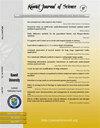金菖蒲树皮甲醇水提物的保护作用r . Br。抗rsl3诱导的铁下垂
IF 1.1
4区 综合性期刊
Q3 MULTIDISCIPLINARY SCIENCES
引用次数: 0
摘要
铁下垂是一种铁依赖性的非凋亡细胞死亡形式,与各种人类病理生理状况有关,其调节可能具有治疗潜力。植物中含有丰富的针对多种疾病的生物活性化合物,而Alstonia scholaris (L.)r . Br。在当地被称为“Dita”,以其生物活性而闻名,如抗氧化、抗炎和保护肝脏的特性。然而,其调节细胞死亡的能力,特别是铁下垂,尚未被探索。本研究探讨了槐皮提取物的抗氧化作用及其对HT-29细胞凋亡的影响。2,2-二苯基-1-苦味酰肼(DPPH)测定结果表明,黄芪提取物具有显著的自由基清除活性(IC50 = 0.24 mg/mL),这可能是由于其总酚(26.83±3.51 mg没食子酸当量/g粗提物)和类黄酮(7.59±1.59 mg槲皮素当量/g粗提物)含量有限所致。在0.1875 mg/mL的浓度下,提取物对ras -选择性致死3 (RSL3)诱导的铁死亡的HT-29细胞的保护水平与标准抑制剂铁抑素-1相当。气相色谱-质谱联用(GC-MS)和液相色谱-质谱联用(LC-MS)分析表明,槲皮提取物中可能分别含有奎宁酸和厚朴酚,这两种物质可能与槲皮提取物的抗氧化作用有关。最后,为了探索奎宁酸和厚朴酚在抑制铁死亡中的可能作用,研究人员进行了与血红素加氧酶1 (HO-1)的分子对接模拟,结果表明,与共晶抑制剂(结合自由能,BFE =−7.64 kcal/mol),特别是厚朴酚(BFE =−7.22 kcal/mol)的相互作用相当。这些结果表明,有可能发现新的铁下垂调节剂在金针叶提取物,然而,需要进一步的研究来最终确认这些化合物在提取物中的存在和活性。本文章由计算机程序翻译,如有差异,请以英文原文为准。
Protective effect of aqueous methanolic bark extracts of Alstonia scholaris (L.) R. Br. against RSL3-induced ferroptosis
Ferroptosis is an iron-dependent form of non-apoptotic cell death that has been implicated in various human pathophysiological conditions and its regulation may have therapeutic potential. Plants have been a rich source of bioactive compounds targeting various diseases, and extracts from Alstonia scholaris (L.) R. Br., locally known as “Dita”, are known for their biological activities such as antioxidant, anti-inflammatory, and hepatoprotective properties. However, its ability to regulate cell death, specifically ferroptosis, has not yet been explored. In this study, the antioxidant potential of A. scholaris bark extract and its effects in the execution of ferroptosis in HT-29 cell line were investigated. 2,2-diphenyl-1-picrylhydrazyl (DPPH) assay demonstrated that A. scholaris extract possesses significant radical scavenging activity (IC50 = 0.24 mg/mL) which may be accounted for by its modest amount of total phenolic (26.83 ± 3.51 mg gallic acid equivalent/g crude extract) and flavonoid (7.59 ± 1.59 mg quercetin equivalent/g crude extract) compounds. At a concentration of 0.1875 mg/mL, the extract rescued HT-29 cells against RAS-selective lethal 3 (RSL3)-induced ferroptosis to levels comparable with the standard inhibitor ferrostatin-1. Gas chromatography-mass spectrometry (GC-MS) and liquid chromatography-mass spectrometry (LC-MS) analyses suggest the possible presence of quinic acid and magnolol, respectively, both of which could contribute to the observed antioxidant property of the A. scholaris extract. Finally, to explore the possible role of quinic acid and magnolol in inhibiting ferroptosis, molecular docking simulations with heme oxygenase 1 (HO-1) were carried out which demonstrated preferable interactions that were comparable with a co-crystalized inhibitor (binding free energy, BFE = −7.64 kcal/mol), particularly magnolol (BFE = −7.22 kcal/mol). These results demonstrate the potential of finding novel ferroptosis regulators in A. scholaris extracts, nevertheless, further studies are needed to conclusively confirm both the presence and activity of these compounds in the extract.
求助全文
通过发布文献求助,成功后即可免费获取论文全文。
去求助
来源期刊

Kuwait Journal of Science
MULTIDISCIPLINARY SCIENCES-
CiteScore
1.60
自引率
28.60%
发文量
132
期刊介绍:
Kuwait Journal of Science (KJS) is indexed and abstracted by major publishing houses such as Chemical Abstract, Science Citation Index, Current contents, Mathematics Abstract, Micribiological Abstracts etc. KJS publishes peer-review articles in various fields of Science including Mathematics, Computer Science, Physics, Statistics, Biology, Chemistry and Earth & Environmental Sciences. In addition, it also aims to bring the results of scientific research carried out under a variety of intellectual traditions and organizations to the attention of specialized scholarly readership. As such, the publisher expects the submission of original manuscripts which contain analysis and solutions about important theoretical, empirical and normative issues.
 求助内容:
求助内容: 应助结果提醒方式:
应助结果提醒方式:


